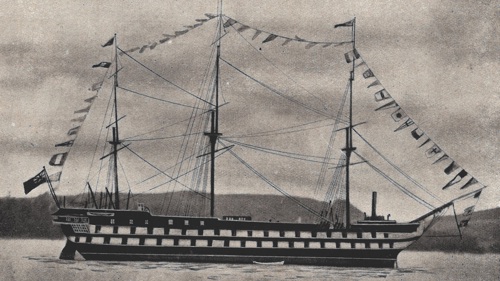Clyde Industrial Training Ships - Times Past

In partnership with the Glasgow Times, our archivists are exploring Glasgow's fascinating history. This week, Barbara McLean writes about the Clyde industrial training ships.
The Empress, an industrial training ship once anchored at Rhu in the Gareloch, has been gone from those waters for almost a hundred years. Yet it had a significant impact on generations of Glaswegian boys.
Following the Industrial Schools Act of 1865, The Clyde Industrial Training Ship Association was formed in November 1868. It aimed to provide a home to receive, educate and train boys who had been left destitute and homeless through poverty, neglect or family loss. As well as receiving a general education, the boys (aged between twelve and fifteen) were also trained in naval matters. This vocational training equipped the boys to become sailors in either the merchant navy or Royal Navy.
The Association’s first object was to source a ship which would act as both home and training centre. On application to the Admiralty, the Association was granted the use of H.M.S. Cumberland. This ship was brought up to the Gareloch to be altered, fitted up and furnished before its certification as an Industrial School ship under the Act. The money for this was acquired through an appeal to the large mercantile and shipping communities along the Clyde. The ship’s officers comprised both general and nautical teaching staff and the first intake of boys was received on board during the summer of 1869.
For the next twenty years, over two and a half thousand boys were educated and trained on board the Cumberland. Most of these boys were Glaswegian. Each day required an early start, usually before 6am (except in winter), and each boy was expected to scrub the decks before beginning his schooling. The boys’ nautical training included identification and practical use of knots; navigation at sea and a knowledge of naval terms. After discharge, many found employment at sea including several who became not only officers of merchant ships but masters. Others found employment on shore as railway porters, miners, carpenters and caulkers among other occupations.
Yet the conditions on board were undeniably harsh. The days were strictly regimented, and boys could be punished by being whipped or restricted to a diet of bread and water. This may explain why, on a February night in 1889, a group of young sailors set the Cumberland on fire. Accounts held in our collections relate how the group gained access to a store-room in which a number of straw mattresses were held. Heaping them together and lighting them on fire, they covered the flames with a blanket and fled. By the time the fire was discovered, it was too late. The captain ordered a full evacuation. While there was no loss of life or injury, all the officers’ possessions and ship stores were destroyed including the pipe band’s instruments.
Recovery was necessary. The total destruction of the Cumberland forced the Association to apply for another ship. The H.M.S. Revenge was granted by the Admiralty on the condition that its name was changed and so it was: to H.M.S. Empress. It would rest on the Gareloch and continue the Association’s work for over thirty years before being broken up in 1923.

